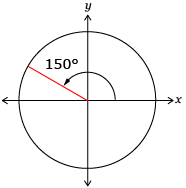Discover
Try This 1
Open Coterminal Angles and answer the following questions.
- Drag the slider at the bottom of the screen so that the blue terminal arm rotates counterclockwise to 150°. You can use the arrow keys on your keyboard to move the slider in smaller increments. The terminal arm should line up with the existing black terminal arm. This angle is recorded for you in the table that follows.
- From 150°, move the slider so that the blue terminal arm rotates counterclockwise until the blue terminal arm lines back up with the black terminal arm. Record this new angle, in degrees and radians, and sketch a diagram of the angle in the next row of a table like the one shown.
- Repeat the step you completed in question 2. Record the new angle and add a diagram to your table.
- Predict the next counterclockwise angle where the blue terminal arm would line up with the black terminal arm. Note this angle and add a diagram.
- Return the slider to 0°. Move the slider so that the blue terminal arm rotates clockwise until it lines up with the black terminal arm. Record this angle and add a diagram to your table (in the row marked Clockwise Angle).
- From this angle, move the slider so that the blue terminal arm rotates clockwise one more rotation to line up with the black terminal arm. Add the angle and diagram to your table.
- Predict the next counterclockwise angle where the blue terminal arm would line up with the black terminal arm. Record your prediction in your table.
Degrees Radians Diagram Counterclockwise Angle 150° 

Angle After One Counterclockwise Rotation Angle After Two Counterclockwise Rotations Angle Predicted After Three Counterclockwise Rotations Clockwise Angle Angle After One Clockwise Rotation Angle Predicted After Two Clockwise Rotations
![]() Save your responses in your course folder.
Save your responses in your course folder.
Share 1
Discuss your responses to Try This 1 with a classmate. In your discussion, respond to the following questions.
- What pattern do you see that could help determine the angle after multiple clockwise rotations? How is this different from the pattern for counterclockwise rotations?
- Coterminal Angles did not let you rotate the terminal arm more than 3 rotations. How could you determine the angle after 4 counterclockwise rotations? How about after 4 clockwise rotations?
- How is your process different depending on whether you are working in degrees or radians?
![]() If required, save a record of your discussion in your course folder.
If required, save a record of your discussion in your course folder.
